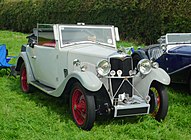Riley 12/6
The Riley 12/6 was a car made by the British Riley company from late 1932 (for the 1933 model year[2]) to 1935.
| Riley 12/6 | |
|---|---|
 Riley 12/6 Lincock fixed head coupé | |
| Overview | |
| Manufacturer | Riley |
| Production | 1932–1935 |
| Designer | Percy and Stanley Riley |
| Body and chassis | |
| Body style | 4-door saloon 2-door coupe 2-door convertible |
| Powertrain | |
| Engine | 1.5 L Straight-6 |
| Dimensions | |
| Wheelbase | 114 in (2,896 mm)[1] |
| Chronology | |
| Predecessor | None |
| Successor | Riley 12/4 |
It had a 1458 cc straight-six engine with twin cams and either single, twin or triple SU carburettors. The transmission was either a four speed manual or optional preselector gearbox. They were capable of a top speed of around 70 mph (113 km/h).[1] The chassis was a lengthened version of the one used on the Riley Nine.
They were available in a range of models: Mentone saloon, Kestrel saloon, Lincock fixed head coupé, Ascot drophead coupé with dickey seat, Lynx tourer, Falcon saloon, Gamecock tourer, March two-seat tourer, MPH two seater trial/sports 2-seater, and Trinity 3-position Drophead Coupé.
The 12/6 engine was designed to fit in between the 9 and 14/6 engines for trialing and racing purposes. The 9 was 1087 cc, fitting in the 1100 cc class, and the 14/6 was 1633 cc, fitting in the over-1500 cc class. A 1486 cc "Brooklands Six" was developed to compete in the sub-1500 cc International Class F, with two or three cars built in mid-1932.[3] Another such engine was fitted to an Alpine Tourer for the 1932 Monte Carlo Rally, where it finished second in class.[4] The 1458 cc 12/6 was derived from the Brooklands Six. The slightly larger "Brooklands" engine continued to see some limited use, such as in the 1933 Riley Grebe prototype and in the TT Six.[2]
As the 14/6 was basically a 9 with two extra cylinders on the end, the 9 and 14/6 engines shared the same parts and spares. The 12/6 didn't share parts with any other Riley, so many 12/6s have been bored out to the size of a 14/6 to compensate for spares. All of these engines share the same 95.2 mm (3.75 in) stroke. The 12/6 has a 57 mm (2.24 in) bore, while the "Brooklands" competition engine has a 57.546 mm (2.27 in) mm bore.
Gallery
 1933 Riley 12/6 Ascot drophead coupé
1933 Riley 12/6 Ascot drophead coupé.jpg.webp) 1934 Riley 12/6 Kestrel saloon
1934 Riley 12/6 Kestrel saloon
References
- Culshaw; Horrobin (1974). Complete Catalogue of British Cars. London: Macmillan. ISBN 0-333-16689-2.
- "Riley 1933". Classic Car Catalogue. Archived from the original on 9 August 2020.
- "Riley 1932". Classic Car Catalogue. Archived from the original on 13 December 2020.
- Hamberg, Erik (1998). "Rileys svenska Monte Carlo-historia" [Riley's Swedish Monte Carlo history] (PDF). Rileybladet (in Swedish). Svenska Rileyregistret. 20 (2): 1. Archived from the original (PDF) on 13 December 2020.